9 Tips for Photographing Sunrises and Sunsets
Written by: Steve RussellThere are hundreds of articles available on this subject but hopefully I’ll be able to provide a little different perspective on the subject. Also, there are millions of sunrise and sunset photos. Yet, people continue to photograph them so why is that? My belief is just like no two snowflakes are alike, neither are two sunsets or sunrises. The planet we live on provides us with so many variables that combine to create what we see that the odds of everything coming together exactly the same as before are astronomical. And that is why we keep working to capture that sunset or sunrise that has that WOW factor for us.
Planning and Timing are both Very Important
What time is the sunset? If the sunsets at 7:30pm (1930 hrs) and you’re still driving to your favorite location at 7:45, you just missed the sunset. Same rule for sunrises, you snooze, you lose – literally. Find out what time the celestial event occurs and be there early.
I’m going to introduce some technical terms that will help with your planning. There are three named twilights – civilian or civil, nautical and astronomical. The complete definitions of the three twilights include how many degrees the sun is below the horizon but briefly they are:
• Evening civil twilight, also called dusk, begins when the sun disappears below the horizon and ends 30 minutes later. During civil twilight the horizon is visible and you can see well enough to engage in most outdoor activities. Civil twilight also has legal ramifications, for example in most states you are required to turn on the headlights of your car no later than 30 minutes after sunset or at the end of evening civil twilight.
• Evening nautical twilight begins 30 minutes after sunset (at the end of civil twilight) and ends one hour after sunset. During nautical twilight the general outline of objects on the ground, under clear skies and without urban light pollution, can generally be discerned but not clearly enough to engage in detailed outdoor operations. At the end of evening nautical twilight the horizon can no longer be discerned. You could also say that it’s dark outside. Nautical twilight has military implications as BMNT (Beginning of Morning Nautical Twilight) and EENT (End of Evening Nautical Twilight) are important considerations in military planning.
• The end of astronomical twilight occurs one and a half hours after sunset and is the time when it’s dark enough to make all astronomical observations. Unless you’re photographing star trails or making astronomical photographs, etc., astronomical twilight is not applicable to photography.
While I used mostly evening twilight in the discussion above, morning twilight is the same but reversed.

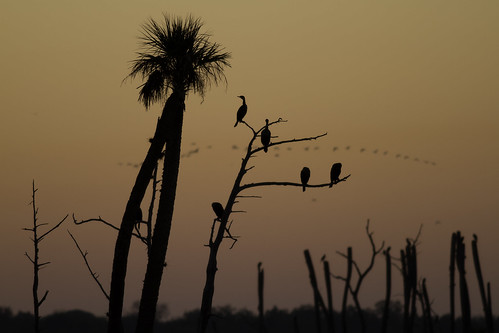
Why is this important, you ask? Because the best color and the best shots are frequently before the sun rises or after it sets. Both of these photos were taken from the same location during civil twilight on different days. Except for some adjustments to the image size I haven’t made any adjustments to these photos in Photoshop. Sunrises on different days provide very different color results.
How do you discover the time for sunsets and sunrises? The information is available from a number of sources including most local newspapers. However, I use a great software product called The Photographer’s Ephemeris and have it installed on both my desktop and iPhone. Why both? I can plan at home and have my iPhone with me to make adjustments in my set-up while it’s still dark if I’m shooting sunrises. In addition to the times of the twilights and the sunrises and sunset, The Photographer’s Ephemeris also gives a compass reading from your location to the point on the horizon where the sun will rise or set.
Why have I spent so much time on this subject? Primarily because you’re not really photographing the sun. You’re photographing the light and at that time of day the light changes by the minute. to get the best shots, you have to be ready beforehand.
Composition is Important
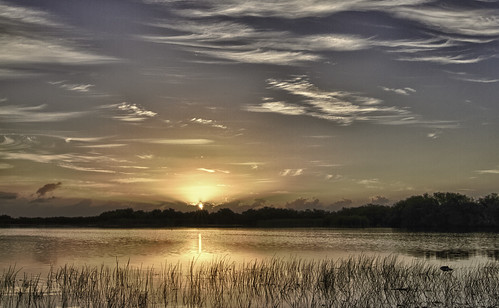
Composition is at least as important in photographing sunrises and sunsets as in photographing other subjects. As I said above, you aren’t really photographing the sun so compose your photograph using the other elements available – trees, buildings, animals, etc. Think of it this way, you’re photographing the lake and trees at sunrise, not the sun rising over the lake and trees. If you want the sun in the image, use the Rule of Thirds to place the sun. The photo above was planned and framed at least 30minutes before the sun ever peeked over the horizon.
Memory is Cheap
The light and shadows are constantly changing at sunset/sunrise and during civil twilight. Capture lots of images. Don’t miss that great shot because you’re not using the shutter release enough.
HDR Can Be Your Friend When Photographing Sunrises/Sunsets

When photographing sunrises and sunsets I always take 3 exposures at a time – normal exposure, plus two stops and then minus two stops. While there are times that the normal exposure is exactly what I’m looking for – for example the two photos above taken during civil twilight are not HDR. The one I used as a compensation example and the one immediately above are HDR.
Sunsets and Sunrises Don’t Look the Same
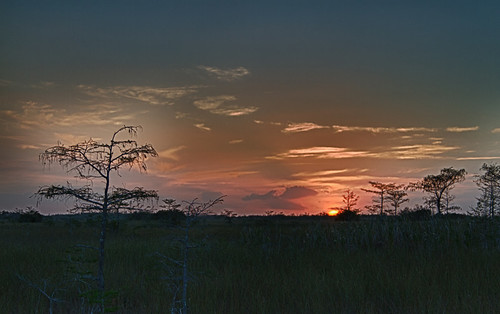
This may seem counter-intuitive. After all, the sun is on the horizon at both times. However, in the morning light is slowing being added to the environment and in the evening light is being slowly subtracted. It gives the scene different tones and colors. While not 100% of the time, I can usually look at a photo and tell whether it’s sunset or sunrise. So, if you’re an early bird and always photograph sunrises you’re missing out on a different look and feel by not working with sunsets as well.
Use Props
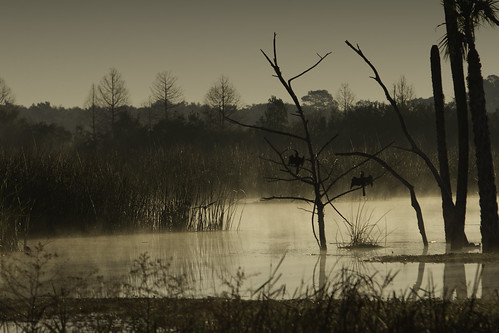
Remember, you aren’t really taking a photograph of the sun. It’s just a big orange ball of fire. It’s the way the sun lights the scene you’re photographing that you want to capture. Don’t stop once the sun rises. Keep looking for subjects after the sun has risen but is still very low or touching the horizon. This photo was taken within two or three minutes after the sun had risen. The fog, the two Anhingas, the trees and the water were all props that were enhanced by the sunlight. It’s an image that wasn’t available ten minutes later.
Clouds are your friends. It’s amazing what the sunlight does to them. The opposite is also true. If there are no clouds, you can usually pack up and go home.
Take Advantage of Silhouettes
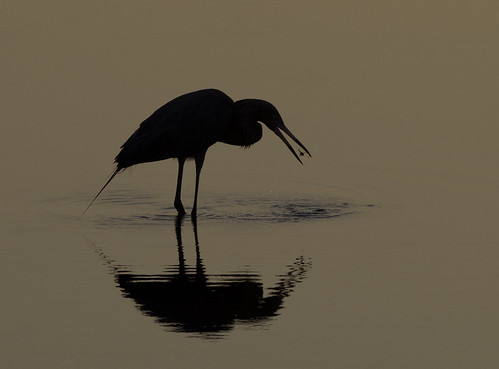
Once the sun is up, capture images that are between you and the sun, but don’t include the sun. I’ve used this image in articles before but it really illustrates the point.
Be There and Be Ready
If you miss the great light, you can’t get it back. It’s gone at a speed of about 186,000 miles a second. If I’m photographing sunrises, I’m set up and ready at the beginning of nautical twilight. For sunsets, I’m there and ready about 30 minutes before sunset and I stay until the end of nautical twilight. I also always set up on a tripod and use a cable or remote shutter release. Why? See HDR can be your friend above. Don’t worry that the most awesome sunsets/sunrises you see are when you’re driving down the highway with your camera back at home. Keep working at it and you’ll get lucky.
Don’t Point Directly at the Sun
My lawyers made me include this one. Actually no lawyers were involved but while common sense would suggest that no one would do this, I’ve seen it happen. Don’t point the camera directly at the sun and especially don’t be looking through the viewfinder when you do. Besides, the image won’t be worth anything anyway.
If you don’t like sunset/sunrise photos, don’t take them. However, it is possible to get some really dramatic shots so go out and give it a try.

No comments:
Post a Comment